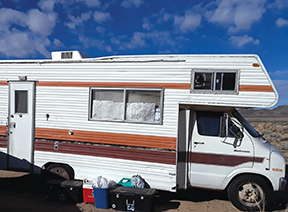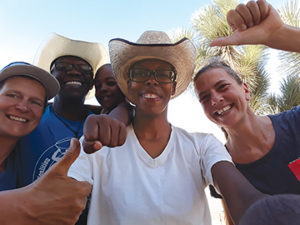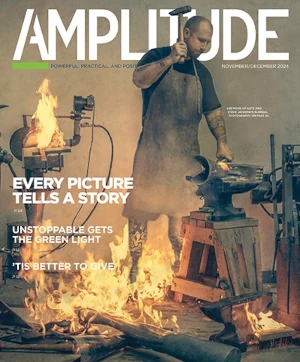By Eric Quander
As amputees, we may sometimes feel that when we lost our limb(s), so went our zing for life. We may appear to have lost hope, direction, and any interest in exploring anything new. When I went through such feelings as a newer left below-knee amputee, it became important to me that I pursue completing at least one of the items on my bucket list.
A bucket list is a list of goals that someone wishes to complete before he or she “kicks the bucket,” or dies. No one is really sure where the term originated, but a few historical references might provide clues. To repel evil, a burial practice of the early Catholic Church included the placing of a bucket of holy water at the feet of the deceased. Mourners would dip their hands into the water and sprinkle a bit of it upon the corpse. Another tradition refers to the unfortunate guy or gal, who, after a series of apparently bad decisions, finds himself or herself noosed and perched upon a bucket. Shortly thereafter, an executioner kicks the bucket, sending the bucket flying and the unfortunate into the waiting arms of the Grim Reaper. Despite these morbid images, most people with knowledge of pop culture would likely agree that the concept was made most popular by the 2007 film The Bucket List, starring Morgan Freeman and Jack Nicholson. The cinematic romp follows two senior citizens, both diagnosed with terminal cancer, as they escape the confinement of their hospital and set about to fulfill a list of long-dreamed-of adventures.
If you’ve gone through a life-changing event, it may prompt you to evaluate priorities, assess your life, and set out to develop such a list. You may recognize that another day is not promised and that life is too short to defer your dreams. What comprises a bucket list is personal and runs the gamut from attending an opera to climbing Mount Everest.
The items on your bucket list will undoubtedly take you outside your comfort zone and present you with some challenges. But aiming ain’t always easy, and things happen in life that leave the bucket riddled with attempted shots. There are few better prompts for you to reload, take another shot, and go after something you have always wanted than an amputation.
I can hear a collective groan from recent amputees: “You think I should now do something I never attempted when I had all my limbs?” Yes! One of the philosophies I’ve developed since my amputation is that sometimes radical change requires radical action. My amputation was the radical change that inspired me to take a radical action. Before my amputation, my wife and I spent many nights watching the Bob Wells YouTube series, CheapRVliving. Whether highlighting a recent retiree who always wanted to travel, a typical American escaping the grind of a 9-to-5 job, or a student trying to graduate college with as little debt as possible, the videos feature individuals who have traded the typical brick-and-mortar domicile for a nomadic lifestyle in their car, van, truck, or converted bus. My wife and I were inspired by Wells’ videos, sharing how much we wanted to surf the amber waves of grain throughout our great state and see what happened. The universe was listening, and things have a funny way of working out—a fire burned down our house, and I became an amputee. With no place to call home, we did what Morgan Freeman’s character suggested in The Shawshank Redemption: We “got busy living” and bought an RV, which we christened “The Black Lotus,” symbolic of the unfolding of our impending adventure.

Although the RV wasn’t in the greatest shape, it was cheap, and we figured we could make it work. We didn’t feel a need to determine exactly how long we might be on our Quanderlust, but we were committed and swore to enjoy the journey and let the lotus unfold. We spent 11 months cavorting up and down California, and the road proved fertile ground for forgotten seeds to take root and new blossoms to bloom. My wife dove into her passion of taking nature photos, and I began writing again, for the first time in years. Most nurturing was connecting with others. We met many other travelers, including Adam and Elizabeth Paashaus and their daughters, who travel in their converted bus and whose kindness reminded me of a warm Southern night; cyclists Ilka Baarss and Nadine Troschke, a German couple we met as they camped under a Joshua tree, destination Alaska; and a fellow named Tom, with whom I shared a passion for Walt Whitman and too-sweet coffee. Everyone sought to be helpful, whether it was lending a tool, recommending the best places to park overnight, or what communities have the most services for vagabonds such as ourselves. I might have never had these communions had I not taken the chance and decided to check off at least one item on my bucket list.

Parked in a mostly forgotten part of the desert, the night illuminated by a star-filled sky and the lights of other camps, my wife would whisper how she felt like we were part of a ragtag collection of survivors of a zombie apocalypse. I figured, as always, she had a point. We can easily find ourselves in a zombie-like trance in the early days of life after amputation. Stumbling through a mire of uncertainty, bemoaning our outcast state, existing but not living. Creating and engaging our bucket list can be the shock to the spirit we need to realize that life is not over and there is still a world that yearns to be seen and appreciated.
If your bucket has a hole in it from which the zest of life slowly leaks, don’t wait until death approaches to do something; consider taking some time to patch the gap and refill it with new goals today. Take a hike, go to a museum, sit on a bench in your local park—just get busy. As you develop your emotional bucket list, be sure to include learning, laughing, and loving more. I guarantee you’ll learn and discover new things about yourself and the world around you.



